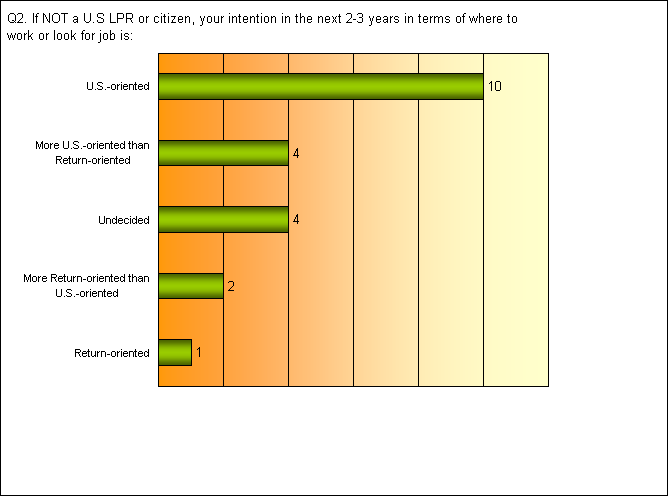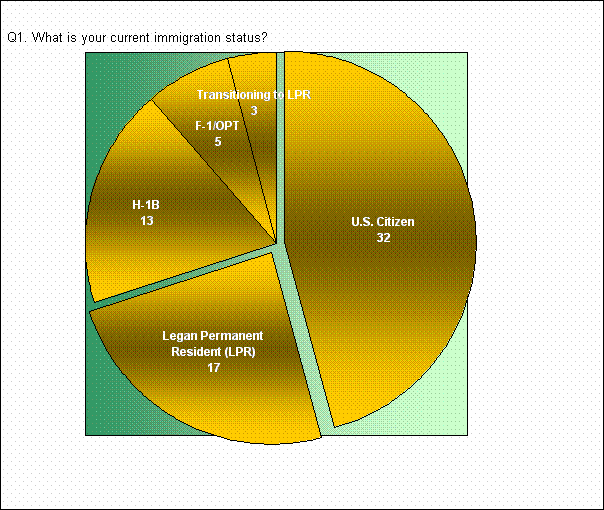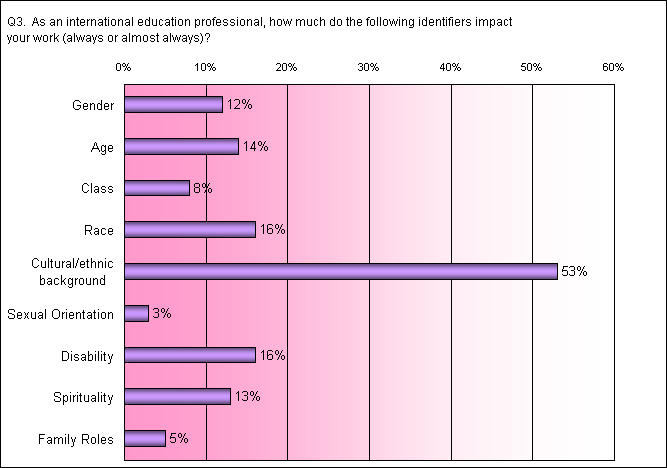
| Respondent's profile (N=70) | ||||||||||
| Gender | Region of birth | Age | ||||||||
| Female | 49 | 70.0% | Asia | 30 | 42.9% | 20-29 |
16
|
22.9% | ||
| Male | 20 | 28.6% | Europe | 16 | 22.9% | 30-39 |
27
|
38.6% | ||
| Unspecified | 1 | 1.4% | C. & S. America | 10 | 14.3% | 40-49 |
18
|
25.7% | ||
| Africa | 4 | 5.7% | 50-59 |
8
|
11.4% | |||||
| Primary Sectional Affiliation | Middle East | 3 | 4.3% | 60+ |
1
|
1.4% | ||||
| CAFSS | 49 | 70.0% | N. America | 3 | 4.3% | Average |
37.8
|
|||
| ADSEC | 9 | 12.9% | Oceania | 1 | 1.4% | Std. Deviation |
9.8
|
|||
| SECUSSA | 8 | 11.4% | Unspecified | 3 | 4.3% | |||||
| COMSEC | 2 | 2.9% | ||||||||
| ATESL | 1 | 1.4% | ||||||||
| OSEAS | 1 | 1.4% | ||||||||
| Years in the field | Current position | Annual salary | ||||||||
| 0-3 years | 28 | 40.0% | Student | 3 | 4.3% | Less than $24,999 |
7
|
10.0% | ||
| 4-6 | 16 | 22.9% | Entry level | 15 | 21.4% | $25,000-29,999 |
7
|
10.0% | ||
| 7-9 | 10 | 14.3% | Expert/Specialist | 9 | 12.9% | $30,000-34,999 |
16
|
22.9% | ||
| 10+ | 16 | 22.9% | Middle Management | 30 | 42.9% | $35,000-39,999 |
8
|
11.4% | ||
| Average | 6.2 | years | Senior Management | 11 | 15.7% | $40,000-44,999 |
7
|
10.0% | ||
| Std. Deviation | 5.3 | Other | 2 | 2.9% | $45,000-49,999 |
6
|
8.6% | |||
| $50,000-54,999 |
7
|
10.0% | ||||||||
| $55,000 or more |
12
|
17.1% | ||||||||

|
Analysis for Q1:
Current immigration status
|

|
Analysis for Q2:
U.S. - oriented or Return-oriented?
|

| Analysis for Q3:
Key cultural identifiers at work FBIEs, as with any other group of people, carry multiple cultural identifiers. This question was set up primarily to see which cultural identifiers play a large role at their workplace. As it turns out, cultural/ethnic background is the most salient marker that impact their work. The next section provides excerpts/summary of comments regarding how FBIEs deal with their "identifiers" at work. . |
|
Q4. Please describe
a situation or context in which certain identifiers above impact your
work as an international educator. (Individuals'
responses to Q4 can be viewed here.) |
|
Analysis for Q4:
How cultural background can work for and against FBIEs By far the most common theme emerging from the responses focused on the fact that respondents believe that their ethnicity/foreign cultural background allows them to encounter their students with greater empathy than someone who has not walked in international student shoes in the U.S. Some, however, caution that at the same time their ethnicity/foreign cultural background and resultant empathy at times detract from their credibility with American colleagues. Here are a few examples:
Communication with colleagues who are not used to dealing with different communication styles or who have a hard time trusting ESL speakers' language abilities were cited as a negative impact by FBIE's who view themselves as good speakers of English. And, finally, religion was mentioned as an often salient factor by those who worked at a religiously affiliated institution or who are Muslim. |
For questions or comments
about the survey, please contact Jin Abe
(jin.abe@wmich.edu)